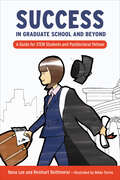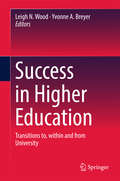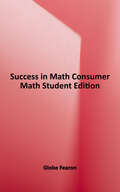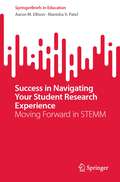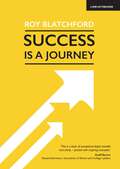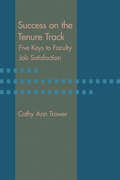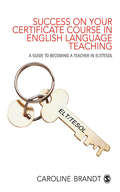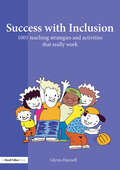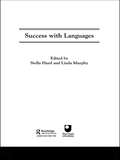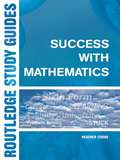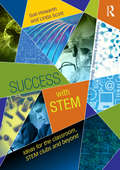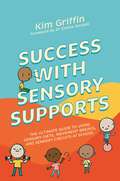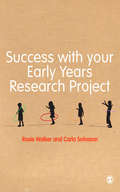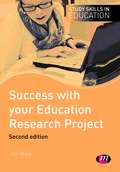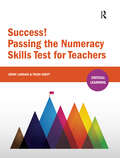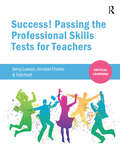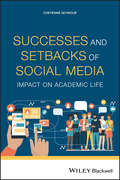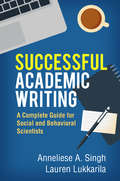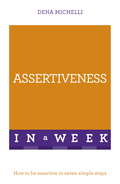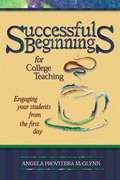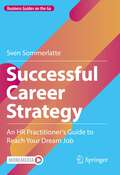- Table View
- List View
Success in Graduate School and Beyond: A Guide for STEM Students and Postdoctoral Fellows
by Nana Lee Reinhart ReithmeierSuccess in Graduate School and Beyond is designed to empower graduate students and postdoctoral fellows in STEM with practical tools, tips, and skill development strategies to plan and create their dream career pathway. Intended as a professional development course book, this balanced, self-reflective guide to workplace readiness is organized into five sections that support graduate student development: self-reflection, wellness, skills, networking, and planning for future success. Written in a conversational style, this guidebook includes clear learning outcomes based on the authors’ successful graduate professional development course at the University of Toronto. Covering increasingly important career subjects such as mentorships, transferrable skill development, emotional intelligence, and EDI, this guidebook solves a skills gap and builds core competencies demanded from industries and academia. Interspersed personal accounts from the authors about key topics and seven Alumni Career Profiles describing various career trajectories work to encourage self-awareness and promote essential skill development and networking proficiency. With this book, STEM students will be equipped with the abilities and tools to achieve success in graduate school and beyond.
Success in Higher Education
by Leigh N. Wood Yvonne A. BreyerThis book explores successful transition strategies to, within and from university for students from around the globe, with Macquarie University, a large Australian university, studied in depth. It addresses the meaning of success taking a variety of perspectives, including student, staff and employer views. The chapters present a series of initiatives that have proven to be successful in assisting students in developing their academic potential throughout university and beyond. The authors of the chapters use a variety of methodologies and approaches reflecting the diverse local contexts and requirements. These international perspectives demonstrate a triumph of practice that has led to the empowerment of individuals and groups. The approaches from twelve universities located in eight different countries stem directly from the coalface and provide many valuable lessons and tools that colleagues in the sector will be able to consider and adapt in their own contexts. Small interventions matter, from a mentor of a nervous student who goes on to achieve greatness, to the use of a curriculum design model that hooks a whole group of students into learning and achievement. This book covers both the small, individual victories and the larger scale strategies that support success. Contributions emanate from Australia, Bangladesh, India, China, New Zealand, United Kingdom, Canada, USA, Uruguay and South Africa.
Success in Math: Consumer Math (Success in Math Series)
by Globe FearonThis book helps students with varying learning styles master basic math concepts and prepares them for success on math competency tests. Student Texts This five-book softcover series breaks down core math concepts into short, manageable lessons that assume little background knowledge and are introduced in real-life contexts. In addition, chapter opener vocabulary lists and a glossary prove valuable for English language learners with below- or at-level math skills. Teacher's resources include answer Keys, as well as error analysis notes, alternative strategies for varied learning styles, problem-solving strategies, ESL notes, cooperative learning strategies, and reproducible masters are provided. - Helps students with varying learning styles master the basic math concepts they need to meet rigorous high school math and testing requirements. - Introduces students to the working world by presenting real-world examples and problems. - Supports independent learning with instruction, exercises, and partial Answer Keys.
Success in Mentoring Your Student Researchers: Moving STEMM Forward (SpringerBriefs in Education)
by Aaron M. Ellison Manisha V. PatelThis book is a guide for mentors on how to recruit, mentor, and support students through a student research experience in science, technology, engineering, mathematics, and medicine (STEMM) fields. Being a successful research mentor benefits from the self-awareness and planning, strategies and skills that Success in Mentoring your Student Researchers can help you build and develop. These are useful for mentors working with any students, but especially those who have been minoritized in STEMM or are the first in their family to attend college. The first part of the book introduces mentoring undergraduates and how it differs from traditional classroom instruction, active learning, and flipped classrooms; mentoring is collaboratively teaching research while doing research. A mentored undergraduate research experience also helps your mentees develop the skills necessary to be successful scientists and become part of STEMM communities. The central part of the book presents the undergraduate research experience as a “three-legged stool” whose legs—research, education, and community—each have unique values in advancing your mentees’ path in STEMM and all of which require setting, communicating, and realizing expectations for “success”--your mentees’ and your own. The last part of the book looks beyond the research experience, from evaluating your success as a mentor through helping your mentees to continue to develop and grow their STEMM careers and become mentors themselves. This book is the mentor’s companion to the authors’ book for students, “Success in Navigating your Student Research Experience: Moving Forward in STEMM.”
Success in Navigating Your Student Research Experience: Moving Forward in STEMM (SpringerBriefs in Education)
by Aaron M. Ellison Manisha V. PatelThis book is a complete guide for students on how to make the most of intensive, experiential research outside a college classroom. Engaging in research as an undergraduate can lead to successful and rewarding careers in science, technology, engineering, mathematics, and medicine (STEMM). Being successful in an undergraduate research experience benefits from the self-awareness and planning, strategies and skills that Success in Navigating your Student Research Experience can help you build and develop. The first part of this book describes strategies and processes for finding, applying, and preparing for an undergraduate research experience that matches your own needs and interests. These strategies are useful for any student, but are particularly helpful for individuals who have been minoritized in STEMM or are the first in their family to attend college. The central part of the book presents the undergraduate research experience as a “three-legged stool” whose legs—research, education, and community—each have unique values in advancing your path in STEMM. The last part of the book illustrates the many options for continuing and expanding your path in research. These range from communicating results to colleagues to moving forward with graduate studies and careers in STEMM, in which you can become a mentor to the next generation of students.This book is the student’s companion to the authors’ book for mentors, “Success in Mentoring your Student Researchers: Moving STEMM Forward.”
Success in Professional Experience
by Dyson, Michael and Plunkett, Margaret and McCluskey, Kerryn Michael Dyson Margaret Plunkett Kerryn MccluskeySuccess in Professional Experience has been specifically designed to assist pre-service teachers on their journey to become successful learners and teachers during the practicum component of their degree. The authors present ideas on how to develop fundamental knowledge, skills and competencies, which help to build meaningful and sustainable relationships within educational communities. Each chapter explores a different area of professional experience, including observations, expectations, mentoring, reflective practice and portfolios. There are specific chapters on areas that students often find the most challenging such as: classroom management, ethics and working with diverse student populations, as well as a chapter catering for pre-service teachers coming from a non-English speaking background. Success in Professional Experience is suitable for early childhood, primary and secondary contexts and addresses the learning needs of on-campus and distance education students. It is also a useful guide for the university liaison staff and school based mentors of pre-service teachers.
Success is a Journey
by Roy BlatchfordRoy Blatchford is one of the UK's most respected educationists. 'Success is a Journey' is a beautifully written collection of his recent essays about the education landscape, reflecting Roy's very high regard for teaching and schools. Over the past thirty years, Roy has written widely on school and college inspection, curriculum innovation, global education, policy and politics. His love of classrooms and enjoyment in watching children succeed are always present. His conversations with students, teachers and leaders have informed the content of many of the essays in this collection. Roy Blatchford's influence in establishing national standards in England's schools is evident in the contents of Part Two of the book. He was lead author of the the DfE Teachers' Standards, Master Teacher Standard and National Standards of Excellence for Headteachers. Part Three explains and exemplifies the practice of Blinks, a distinctive approach to reviewing and reporting on education settings which he has, with colleagues, established over the past fifteen years in the UK and internationally.
Success is a Journey
by Roy BlatchfordRoy Blatchford is one of the UK's most respected educationists. 'Success is a Journey' is a beautifully written collection of his recent essays about the education landscape, reflecting Roy's very high regard for teaching and schools. Over the past thirty years, Roy has written widely on school and college inspection, curriculum innovation, global education, policy and politics. His love of classrooms and enjoyment in watching children succeed are always present. His conversations with students, teachers and leaders have informed the content of many of the essays in this collection. Roy Blatchford's influence in establishing national standards in England's schools is evident in the contents of Part Two of the book. He was lead author of the the DfE Teachers' Standards, Master Teacher Standard and National Standards of Excellence for Headteachers. Part Three explains and exemplifies the practice of Blinks, a distinctive approach to reviewing and reporting on education settings which he has, with colleagues, established over the past fifteen years in the UK and internationally.
Success on the Tenure Track: Five Keys to Faculty Job Satisfaction
by Cathy Ann TrowerSatisfaction ratings from tenure-track faculty at 200 institutions across the country reveal best practices and the key elements of workplace success.Landing a tenure-track position is no easy task. Achieving tenure is even more difficult. Under what policies and practices do faculty find greater clarity about tenure and experience higher levels of job satisfaction? And what makes an institution a great place to work?In 2005–2006, the Collaborative on Academic Careers in Higher Education (COACHE) at the Harvard Graduate School of Education surveyed more than 15,000 tenure-track faculty at 200 participating institutions to assess their job satisfaction. The survey was designed around five key themes for faculty satisfaction: tenure clarity, work-life balance, support for research, collegiality, and leadership. Success on the Tenure Track positions the survey data in the context of actual colleges and universities and real faculty and administrators who talk about what works and why. Best practices at the highest-rated institutions in the survey—Auburn, Ohio State, North Carolina State, Illinois at Urbana-Champaign, Iowa, Kansas, and North Carolina at Pembroke—give administrators practical, proven advice on how to increase their employee satisfaction. Additional chapters discuss faculty demographics, trends in employment practices, what leaders can do to create and sustain a great workplace for faculty, and what the future might hold for tenure.An actively engaged faculty is crucial for American higher education to retain its global competitiveness. Cathy Ann Trower’s analysis provides colleges and universities a considerable inside advantage to get on the right track toward a happy, productive workforce.
Success on your Certificate Course in English Language Teaching: A guide to becoming a teacher in ELT/TESOL
by Caroline Brandt`Extremely comprehensive and well written in terms of style - accessible to the reader, but intelligent and expressing some fairly subtle concepts. Would that more ELT practitioners could do the same!... Certainly a good read for those thinking about and also those engaged in initial training - or even post initial training stage' - Jenny Pugsley, Head of TESOL, Trinity College London 'It's essential reading whether you are simply curious about what is involved in training in ELT, need advice on choosing the right course, have already enrolled and want to make the most of your course, or are a new teacher just starting out. It's a book I wish I'd had when I was starting out in my ELT career, and that I wish had been available to many of the course participants I have tutored' - Lyn Strutt, ELT author and Chair of the British Council Families Association Each year, thousands of people all over the world take one of the hundreds of available short pre-service courses that lead to the award of a certificate in English Language Teaching (ELT) or Teaching English to Speakers of Other Languages (TESOL). Caroline Brandt's book is an invaluable guide to anyone thinking of enrolling on one of these courses. With a clear and concise structure that follows your general interest in TESOL right through to the intricacies of the course itself, it can be used from initial research stages to final qualifications, and beyond. Brandt's decades of experience in this field across the globe shine through. Chapters include: -introducing English Language Teaching -becoming qualified -knowing your certificate course -getting started -learning -working together -being qualified. Throughout the book there are snapshots of students' experiences in their own words, and summaries of key points for you to take with you - whether into the next stage of learning or the next day's teaching. The chapters are stand alone resources as well as the building blocks to becoming a fully-qualified English Language teacher. The book is supported by a companion website, which provides quizzes to test understanding of each chapter, lesson plan proformas, a full glossary and annotated website links.
Success with Inclusion: 1001 Teaching Strategies and Activities that Really Work
by Glynis HannellToday's classroom welcomes diversity, where many levels, speeds and styles of learning coexist. Success with Inclusion provides over 1000 specific strategies to help identified areas of difficulty or advanced development. Using this book, teachers will be able to: quickly and easily identify and record their pupils’ individual learning patterns using the observation charts provided structure a well planned inclusive environment implement creative and thoughtful learning interventions. create an atmosphere of flexibility and compassion. Author and experienced teacher Glynis Hannell gets down to the nitty gritty with chapters full of practical and creative ideas that will help accommodate not only pupils with difficulties but also those who are advanced. Learning strategies here will help you to: be an effective inclusive teacher address a variety of reading difficulties support pupils' writing skills make maths comprehensible, fun and relevant enhance pupils' concentration encourage habits of organisation foster teamwork between yourself, colleagues, parents and pupils. The 42 photocopiable worksheets, checklists, charts, games and planners are provided in the appendix to give teachers a headstart. Also here are observation charts, literacy and maths resources, as well as support materials for teachers, pupils and parents.
Success with Languages
by Linda Murphy Stella HurdSuccess with Languages is designed to help all students develop the skills they need to become an effective language learner and to make the most of language study. Written by experienced language teachers at the Open University, this book offers undergraduates and postgraduates crucial and practical advice on important areas such as: choosing a language and study programme setting personal goals for language learning and monitoring progress using ICT to support language learning. Each of the ten chapters features a number of exercises in order to help students assess the ways they learn and consider where improvements can be made, making the most of the media available and how to use resources effectively.
Success with Mathematics
by Heather CookeMany students find the leap between school and university level mathematics to be significantly greater than they expected. Success with Mathematics has been devised and written especially in order to help students bridge that gap. It offers clear, practical guidance from experienced teachers of mathematics in higher education on such key issues as: * getting started* ways of studying* assessment* mathematical communication* learning by doing* using ICT* using calculators* what next.After reading this book, students will find themselves better prepared for the change in pace, rigour and abstraction they encounter in degree level mathematics. They will also find themselves able to broaden their learning strategies and improve their self-directed study skills. This book is essential reading for anyone following, or about to undertake, a degree in mathematics, or other degree courses with mathematical content.
Success with STEM: Ideas for the classroom, STEM clubs and beyond
by Linda Scott Sue HowarthSuccess with STEM is an essential resource, packed with advice and ideas to support and enthuse all those involved in the planning and delivery of STEM in the secondary school. It offers guidance on current issues and priority areas to help you make informed judgements about your own practice and argue for further support for your subject in school. It explains current initiatives to enhance STEM teaching and offers a wide range of practical activities to support exciting teaching and learning in and beyond the classroom. Illustrated with examples of successful projects in real schools, this friendly, inspiring book explores: Innovative teaching ideas to make lessons buzz Activities for successful practical work Sourcing additional funding Finding and making the most of the best resources STEM outside the classroom Setting-up and enhancing your own STEM club Getting involved in STEM competitions, fairs and festivals Promoting STEM careers and tackling stereotypes Health, safety and legal issues Examples of international projects An wide-ranging list of project and activity titles Enriched by the authors’ extensive experience and work with schools, Success with STEM is a rich compendium for all those who want to develop outstanding lessons and infuse a life-long interest in STEM learning in their students. The advice and guidance will be invaluable for all teachers, subject leaders, trainee teachers and NQTs.
Success with Sensory Supports: The ultimate guide to using sensory diets, movement breaks, and sensory circuits at school
by Kim GriffinSensory needs are being recognised as a vital part of learning, development and engagement within the classroom and are being used more often to make education both accessible and fun. To harness the full potential of sensory supports, using these strategies correctly is key!This is the essential guide to using sensory strategies successfully with school children, from occupational therapist, Kim Griffin, who has 20 years of experience supporting sensory needs.As you make your way through the book, you will be joined by Isla and Noah, two children whose stories will help illustrate how information in the book can be used practically. In addition, the book includes personal anecdotes from Kim, links to further reading, reflective questions and teacher perspectives to show how a teacher might use the information in the classroom. These features will help you easily identify sensory needs and use sensory tools effectively.
Success with your Early Years Research Project
by Rosie Walker Carla Solvason'Action research and Early Years practices go together, as naturally as the new day rising. This book is a celebration of new days. Early Years research is a practice for creative thinking for new tomorrows; the book shows us how to do this, and is to be commended for anyone who wishes to find innovative ways to think and act for all new beginnings.' -Jean McNiff, Professor of Educational Research, York St John University Where do you start with a research project? How do you choose a good question? What are tutors looking for in an outstanding project? This book will help you answer all of the above and that is just the beginning. With examples of real research projects from students just like you, it takes you through each step of the process including: Choosing your question and approach Making sure your research is ethical Gathering and analysing data Reaching conclusions Putting your findings into practice. After each example the authors provide commentary on what made each project so good, or what needed more work, helping you see what a good project really looks like. Suitable for anyone tackling a research project as part of the Early Years course, at foundation or degree level, this book will help you make sure your project is interesting, relevant and impacts on your practice.
Success with your Education Research Project
by John SharpSuccess with your Education Research Project is a practical, user-friendly text on research methods aimed specifically at undergraduate students on education courses. Research projects are carried out in schools and non-school settings by nearly all undergraduates in teacher training, Education Studies and other educational disciplines, and this book makes clear references to these courses and contexts throughout. All chapters include learning outcomes, worked examples, practical and reflective tasks and summaries of key points. Topics such as using the net and plagiarism are covered with up to date information, while key content on literature searches, crtical thinking and the development of argument provides clear guidance and ensures deeper understanding. This new edition has been updated throughout to provide greater depth on many topics. Study Skills in Education This series addresses key study skills in the context of education courses, helping students indentify their strenghts and weaknesses, increase their confidence and realise their academic potential. The books are suitable for students on: - any course of Initial Teacher Training leading to the award of QTS (primary or secondary) - degree course in Education or Education Studies with or without QTS - degree courses in Early Years or Early Childhood Studies; - foundation degrees in Education or any education-related subject discipline
Success with your Education Research Project (Study Skills in Education Series)
by John SharpSuccess with Your Education Research Project is a practical, user-friendly text on research methods aimed specifically at undergraduate students on education courses. Research projects are carried out in schools and non-school settings by nearly all undergraduates in teacher training, Education Studies and other educational disciplines, and this book makes clear references to these courses and contexts throughout. All chapters include learning outcomes, worked examples, practical and reflective tasks and summaries of key points. Topics such as using the Net and plagiarism are covered with up to date information, while key content on literature searches, critical thinking and the development of argument provides clear guidance and ensures deeper understanding. This new edition has been updated throughout to provide greater depth on many topics. Study Skills in Education This series addresses key study skills in the context of education courses, helping students indentify their strenghts and weaknesses, increase their confidence and realise their academic potential. The books are suitable for students on: - any course of Initial Teacher Training leading to the award of QTS (primary or secondary) - degree course in Education or Education Studies with or without QTS - degree courses in Early Years or Early Childhood Studies; - foundation degrees in Education or any education-related subject discipline
Success! Passing the Numeracy Skills Test for Teachers (Critical Learning)
by Trish KreftAn ESSENTIAL book for anyone who wants to pass the Numeracy Skills Test for Teachers. You must pass this test before starting your course, and this up to date text tells you exactly what to expect and how to prepare for the latest version of the test. There is an emphasis on support and clear guidance throughout, along with plenty of practice material, so you can face the test with confidence and succeed in your application. It provides: a guide to the variety of Initial Teacher Training (ITT) provision and routes into teaching a preparation timeline comprehensive coverage of the numeracy test an audit of your strengths and areas for improvement in numeracy example questions and answers, highlighting common errors, providing top tips for success, with theories and methods fully explained full practice papers plus test-taking and revision strategies discrete topics enable focused learning, with explanations and hundreds of examples larger format pages for ease of use and more memorable learning.
Success! Passing the Professional Skills Tests for Teachers (Critical Learning)
by Jenny Lawson Annabel Charles Trish KreftAn essential book for anyone thinking of taking, or about to take, the Professional Skills Tests for Teachers. You must pass these tests before starting your course, and this up to date text tells you exactly what to expect and how to prepare for the latest versions of the tests. There is an emphasis on support and clear guidance throughout, along with plenty of practice material, so you can face the tests with confidence and succeed in your application. It provides: a guide to the variety of Initial Teacher Training (ITT) provision and routes into teaching a preparation timeline comprehensive coverage of both the numeracy and literacy tests an audit of your strengths and areas for improvement in literacy and numeracy example questions and answers, highlighting common errors, providing top tips for success, with theories and methods fully explained full practice papers plus test-taking and revision strategies discrete topics within the numeracy and literacy sections enabling focused learning, with explanations and hundreds of examples larger format pages, with topics covered across double page spreads for ease of use and more memorable learning.
Successes and Setbacks of Social Media: Impact on Academic Life
by Cheyenne SeymourDiscover the real-life impacts of social media use through a collection of fascinating academic perspectives Successes and Setbacks of Social Media: Impact on Academic Life rigorously explores the positive and negative impacts of social media as a communication tool. The book incorporates a diverse group of opinions and perspectives, all of which reflect on how social media might influence academic success, relationships, self-worth, and engagement with virtual networks. Accomplished academic and editor Dr. Cheyenne Seymour delivers an insightful examination of the different ways that social media can catapult people into success or failure. Four key areas are explored: academics, authenticity, relationships, and self-worth. Each area contains a synthesis of the latest research, supplemented with contributions that explore the negative and positive aspects of each area. The editor also includes perspectives that discuss emerging technologies, the impact they have on social media, and the impacts they might have in the future. The book offers readers a wide variety of benefits, including: An informative synthesis of peer-reviewed research about the impact of social media on individuals today Chapters that investigate both positive and negative aspects of social media across multiple demographics and usage scenarios Illuminating reports on experiences with several social media platforms, including Facebook, Instagram, and Snapchat An analysis of potential future developments and emerging technologies in social media and the coming social and ethical concerns that might arise Perfect for advanced undergraduate and graduate level students across a variety of disciplines, but particularly in courses on social media, mass communication, relational communication, and strategic communication, Successes and Setbacks of Social Media also belongs on the bookshelves of anyone with even a passing interest in the real-world impacts of social media usage.
Successful Academic Writing: A Complete Guide for Social and Behavioral Scientists
by Anneliese A. Singh Lauren LukkarilaUsing rich examples and engaging pedagogical tools, this book equips students to master the challenges of academic writing in graduate school and beyond. The authors delve into nitty-gritty aspects of structure, style, and language, and offer a window onto the thought processes and strategies that strong writers rely on. Essential topics include how to: identify the audience for a particular piece of writing; craft a voice appropriate for a discipline-specific community of practice; compose the sections of a qualitative, quantitative, or mixed-methods research article; select the right peer-reviewed journal for submitting an article; and navigate the publication process. Readers are also guided to build vital self-coaching skills in order to stay motivated and complete projects successfully. User-Friendly Features *Exercises (with answers) analyzing a variety of texts. *Annotated excerpts from peer-reviewed journal articles. *Practice opportunities that help readers apply the ideas to their own writing projects. *Personal reflections and advice on common writing hurdles. *End-of-chapter Awareness and Action Reminders with clear steps to take.
Successful Assertiveness in a Week: Teach Yourself
by Dena MichelliThe ability to assert yourself - to stand up for yourself while ensuring a win-win outcome - is crucial to anyone who wants to advance their career.Written by Dena Michelli, a leading expert on appraisals as both a coach and a practitioner, this book quickly teaches you the insider secrets you need to know to in order to be assertive.The highly motivational 'in a week' structure of the book provides seven straightforward chapters explaining the key points, and at the end there are optional questions to ensure you have taken it all in. There are also cartoons and diagrams throughout, to help make this book a more enjoyable and effective learning experience.So what are you waiting for? Let this book put you on the fast track to success!
Successful Beginnings for College Teaching: Engaging Your Students from the First Day
by Angela Provitera-McglynnLaying the groundwork for a successful semester starts with the first day of class. Author Angela Provitera McGlynn tells that the first day is not the day to pass out a syllabus and let everyone go. Rather, it's the day to set the context for the rest of the semester. The author stresses the need for developing an atmosphere of respect for diversity while simultaneously providing a safe and exciting place to explore differences. Included are a whole variety of ice breakers and other exercises to keep students engaged and interacting. In addition, such vital issues as environment, motivation, and civility are addressed with suggestions for promoting positive interactions.
Successful Career Strategy: An HR Practitioner's Guide to Reach Your Dream Job (Business Guides on the Go)
by Sven SommerlatteAdvancing your career in the best possible way requires a well-structured and targeted approach. This book offers a basic methodology as well as practical tools and a variety of case studies that are helpful for the development and implementation of a career strategy. It helps to match talents with aspirations in order to encourage candidates to make courageous career decisions and offers guidance on how to choose the professional environment that best fits personal preferences. Thus, it can be a guide to considering your career as a lifelong learning journey that can help you grow as a leader and as an individual.The book is primarily aimed at young professionals who want to develop their career in the most effective way. It is also useful for managers to be able to advise and support the professional development of their team members. Videos via app: download the SN More Media app for free, scan a link with play button and access videos directly on your smartphone or tablet.
